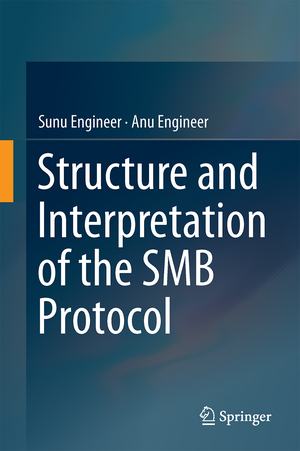Structure and Interpretation of the SMB Protocol
Autor Sunu Engineer, Anu Engineeren Limba Engleză Hardback – 22 dec 2024
This book discusses the current status of the Server Message Block (SMB) protocol and its relevance, use and applications in the data storage world at present. Starting from the origin of the protocol, this book traces the evolution of the protocol through the dark ages, when the protocol was proprietary and its transition into a being an open protocol. It discusses the current applications that use the SMB protocol as well as possible applications in the future.
The analysis of the protocol in this book captures the detailed structure as well as the rationale behind the design. It illustrates the relationship between SMB protocol and other protocols in the context of the Microsoft Windows ecosystem and the assimilation of SMB into other operating system environments such as Linux (Unix), Mac OS, Android, iOS etc.
The questions of performance, scaling and largescale use especially in cloud environments, weaknesses and security issues in the current set of implementations of the protocol are discussed in this book. It also examines the question of interoperability of SMB with other popular NAS protocols exposing distributed file system semantics such as NFSv3 and v4.
This book targets data storage system engineers, computer scientists and researchers working in this field. Advanced-level students studying engineering and computer science will also find this book useful as a secondary text.
Preț: 537.75 lei
Preț vechi: 809.84 lei
-34% Nou
Puncte Express: 807
Preț estimativ în valută:
102.90€ • 107.65$ • 85.48£
102.90€ • 107.65$ • 85.48£
Carte nepublicată încă
Doresc să fiu notificat când acest titlu va fi disponibil:
Se trimite...
Preluare comenzi: 021 569.72.76
Specificații
ISBN-13: 9789811078040
ISBN-10: 9811078041
Pagini: 380
Ilustrații: XX, 380 p.
Dimensiuni: 155 x 235 mm
Ediția:1st ed. 2024
Editura: Springer Nature Singapore
Colecția Springer
Locul publicării:Singapore, Singapore
ISBN-10: 9811078041
Pagini: 380
Ilustrații: XX, 380 p.
Dimensiuni: 155 x 235 mm
Ediția:1st ed. 2024
Editura: Springer Nature Singapore
Colecția Springer
Locul publicării:Singapore, Singapore
Cuprins
Chapter 1. Introduction.- Chapter 2. The Structure of the Protocol.- Chapter 3. The Entities in the Interaction.- Chapter 4. The Exchange of Messages.- Chapter 5. Interpretation of Messages. Chapter 6. Security and Integrity of Resources.- Chapter 7. IO Patterns.- Chapter 8. IO Models.-Chapter 9. IO Performance.- Chapter 10. Cooperative Coexistence.- Chapter 11. Artificial Intelligence and Machine Learning in Storage Protocols.- Chapter 12. How Things Go Wrong. Chapter 13. External Environments.- Chapter 14. Secure Use of the Protocol in a Large Scale Environment.
Notă biografică
Sunu Engineer: With decades of experience in software systems especially in the field of distributed storage, File Systems, Operating Systems etc, Sunu was instrumental in architecting and designing the original version of MoSMB, a proprietary SMB3 implementation on Linux, during his stint as the CTO of Ryussi Technologies Pvt Ltd. The insights gained from that exercise which required a deep study of the protocol as well as the interaction with the many members of the implementation ecosystem across the world led to the formulation of this book.
Anu Engineer: Is a software engineer with over 20 years of experience. He worked in the Windows Team and was part of the founding team of Windows Azure. He wrote the VMware Certificate Server and has made extensive contributions to the open-source. He is a core contributor and program management committee member for Apache Hadoop, Apache Ozone, and Apache Ratis. His most recent stint was in the field of AI and NLP in the field of Legal Contracts as the CTO of Sirionlabs Pvt Ltd.
Anu Engineer: Is a software engineer with over 20 years of experience. He worked in the Windows Team and was part of the founding team of Windows Azure. He wrote the VMware Certificate Server and has made extensive contributions to the open-source. He is a core contributor and program management committee member for Apache Hadoop, Apache Ozone, and Apache Ratis. His most recent stint was in the field of AI and NLP in the field of Legal Contracts as the CTO of Sirionlabs Pvt Ltd.
Textul de pe ultima copertă
This book discusses the current status of the Server Message Block (SMB) protocol and its relevance, use and applications in the data storage world at present. Starting from the origin of the protocol, this book traces the evolution of the protocol through the dark ages, when the protocol was proprietary and its transition into a being an open protocol. It discusses the current applications that use the SMB protocol as well as possible applications in the future.
The analysis of the protocol in this book captures the detailed structure as well as the rationale behind the design. It illustrates the relationship between SMB protocol and other protocols in the context of the Microsoft Windows ecosystem and the assimilation of SMB into other operating system environments such as Linux (Unix), Mac OS, Android, iOS etc.
The questions of performance, scaling and largescale use especially in cloud environments, weaknesses and security issues in the current set of implementations of the protocol are discussed in this book. It also examines the question of interoperability of SMB with other popular NAS protocols exposing distributed file system semantics such as NFSv3 and v4.
This book targets data storage system engineers, computer scientists and researchers working in this field. Advanced-level students studying engineering and computer science will also find this book useful as a secondary text.
Caracteristici
Provides insight into the current capabilities and usage models for SMB3 (Server Message Block) with a deep analysis of the structure of the protocol so that the potential of SMB can be fully realized in many application contexts Presents a much needed analysis of the different implementations of SMB (Server Message Block )protocol that are prevalent and their present and future uses Discusses the questions of performance, scaling and largescale use especially in cloud environments, weaknesses as well as security issues in the current set of implementations of the protocol
